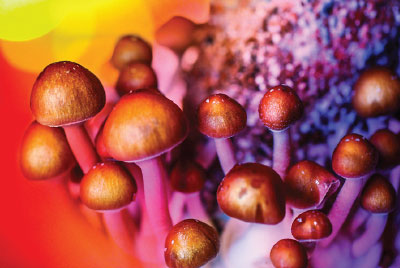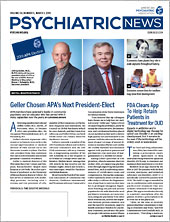Psychedelic compounds such as LSD and magic mushrooms were the subject of a good deal of psychiatric research in the first half of the 20th century. This all changed in 1970, when President Richard Nixon signed the Controlled Substances Act, which in part prohibited the use of psychedelics for any reason. While studies of these drugs waned for a couple of decades as a result, the drugs are slowly making their way back into the laboratory. Numerous, albeit small, studies over the past decade have shown that if used judiciously alongside behavioral therapy, psychedelics can help people with difficult-to-treat mental disorders.
It remains to be seen if these positive results will eventually lead to approved medical use, but a significant step was taken in 2017, when the Food and Drug Administration (FDA) granted breakthrough therapy status to MDMA (also known as ecstasy) to treat people with severe posttraumatic stress disorder (PTSD) (
Psychiatric News, October 20, 2017. A breakthrough tag means that the FDA will expedite the review process for a drug the agency classifies as filling an unmet need in medicine. One year later, the FDA gave a similar designation to psilocybin, the active ingredient in magic mushrooms, for people with treatment-resistant depression.
While both compounds are still likely years away from being approved by the FDA, these breakthrough designations are a big deal, said Matthew Brown, D.O., M.B.A., a psychiatrist at the Heartwood Center in Evanston, Ill. Brown has an interest in psychedelic medicine.
“This could be huge for psychiatry,” Brown said. “Giving this designation means more than just a quicker review process; the FDA is indicating that they have a vested interest in moving these compounds along the drug development pipeline.”
Brown and other psychiatrists who have been following the progress of psychedelic research can understand why the FDA might show this interest. Some results from small studies of psychedelics have been quite promising.
In 2014, a team of Swiss researchers conducted a pilot study to see if LSD could reduce anxiety in people with life-threatening illnesses. A dozen participants with conditions including advanced cancer and Parkinson’s disease were given LSD on two separate occasions (about two weeks apart) in between their regular psychotherapy sessions. The investigators found that two months later, the participants’ average anxiety levels had decreased by over 75 percent. Moreover, this anxiety improvement lasted for 12 months, without any further LSD sessions.
“That is pretty amazing,” said Fernando Espi, M.D., Ph.D., an assistant professor of psychiatry at Rush Medical College in Chicago. “Where else in medicine can you give just two doses of a medicine and then still see reduced symptoms one year later?”
Espi, who conducted a fellowship in psychiatric oncology, told Psychiatric News that psychedelics are well suited for people in a palliative care setting.
“People who have a late-stage illness have an existential form of anxiety related to mortality,” he said. “Psychedelics promote an expanded state of consciousness, which can help people better cope with this.”
The ability of psychedelic compounds to expand one’s consciousness may also benefit patients with severe cases of PTSD and treatment-resistant depression. Researchers are also testing psychedelics for several substance use disorders.
In 2017, researchers at the University of California, San Diego, and New York University completed an observational pilot study that found a chemical extracted from the bark of dogbane trees called ibogaine was effective at helping people with opioid use disorder detoxify and quit. The researchers observed that half of their enrolled patients stopped using opioids 30 days after receiving one dose of ibogaine.
“So far, these have all been early-stage studies, and many of them have self-selection bias,” Espi acknowledged. Pilot studies are usually composed of people who are eager for new treatment and are more likely to report positive responses. Once larger, multisite studies are conducted, the results will likely not be as robust, but researchers may get a better handle on which patient groups would likely benefit the most from psychedelic therapy.
“I know many people have concerns about these altered states of consciousnesses, but it’s important to remember that you don’t need a drug to achieve a psychedelic state,” Brown said. He noted that people have experienced similar states of being using sensory deprivation tanks, sweat lodges, or even intense meditation. These chemicals are just another catalyst to open someone’s mind and make behavioral interventions more effective.
Brown added that psychedelics pose some risks, as is true of any other psychiatric medication. These include both physical risks, such as high blood pressure, and psychiatric risks, notably unwanted, recurring hallucinations (flashbacks). There have also been case reports that these drugs can trigger a psychotic episode, though population-level studies have not identified an elevated psychosis risk among psychedelic users as compared with the general population.
As with other drugs that induce dissociative, mind-altering effects, people who take psychedelics are also potentially at risk of misusing these substances.
“Some people who advocate for decriminalizing psychedelics like to say that these drugs are non-addictive, but I am not sure about that,” said Espi. “Some people take medications to forget their problems, and that always carries a risk of misuse.”
The potential of misuse is compounded since these drugs are currently available on the street. That creates a “double-edged sword,” said Brown. “As societal interest in the medicinal value of these drugs increases, so does the risk of having someone want to try these drugs without a doctor’s help.”
Brown explained that unlicensed use is risky since the effects of psychedelic substances depend heavily on the concepts of set (a person’s mindset) and setting (physical location). “Someone taking MDMA in a safe place with a therapist on hand will have a completely different response than a partygoer taking this drug at a nightclub.” This is why he recommended that any use of psychedelics therapy be done in a professional setting as part of a multimodal treatment.
“There is a lot of excitement about psychedelics in some circles now, but we need to remain in the right frame of mind and not get too enthusiastic or skeptical about their place in psychiatry,” Espi added. “But I do think there is enough evidence to say these compounds deserve to be in the conversation.” ■

